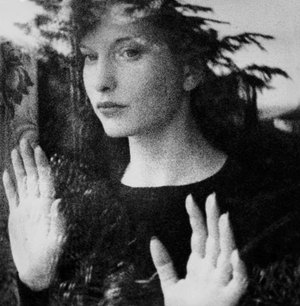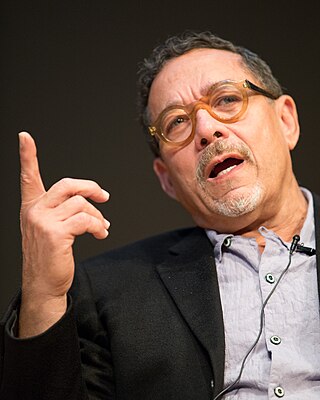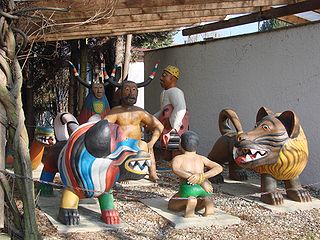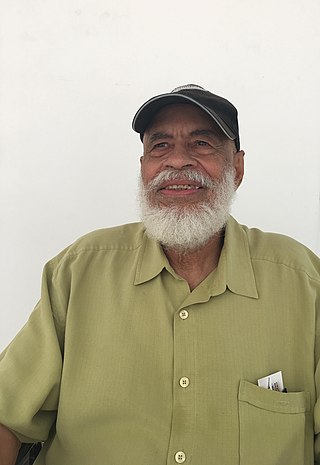Related Research Articles

The Kingdom of Dahomey was a West African kingdom located within present-day Benin that existed from approximately 1600 until 1904. Dahomey developed on the Abomey Plateau amongst the Fon people in the early 17th century and became a regional power in the 18th century by expanding south to conquer key cities like Whydah belonging to the Kingdom of Whydah on the Atlantic coast which granted it unhindered access to the tricontinental triangular trade.

Vodun is a religion practiced by the Aja, Ewe, and Fon peoples of Benin, Togo, Ghana, and Nigeria.

Maya Deren was a Ukrainian-born American experimental filmmaker and important part of the avant-garde in the 1940s and 1950s. Deren was also a choreographer, dancer, film theorist, poet, lecturer, writer, and photographer.

Samella Sanders Lewis was an American visual artist and art historian. She worked primarily as a printmaker and painter. She has been called the "Godmother of African American Art". She received Distinguished Artist Award for Lifetime Achievement from the College Art Association (CAA) in 2021.
“Art is not a luxury as many people think – it is a necessity. It documents history – it helps educate people and stores knowledge for generations to come.” – Dr. Samella Lewis
Alison Saar is a Los Angeles, California based sculptor, mixed-media, and installation artist. Her artwork focuses on the African diaspora and black female identity and is influenced by African, Caribbean, and Latin American folk art and spirituality. Saar is well known for "transforming found objects to reflect themes of cultural and social identity, history, and religion."

Edouard Duval-Carrié is a Haitian-born American contemporary painter and sculptor based in Miami, Florida.
Therman Statom is an American Studio Glass artist whose primary medium is sheet glass. He cuts, paints, and assembles the glass - adding found glass objects along the way – to create three-dimensional sculptures. Many of these works are large in scale. Statom is known for his site-specific installations in which his glass structures dwarf the visitor. Sound and projected digital imagery are also features of the environmental works.

Biography
Karen McCarthy Brown was an anthropologist specializing in the anthropology of religion. She is best known for her groundbreaking book Mama Lola: A Vodou Priestess in Brooklyn, which made great strides in destigmatizing Haitian Vodou. Until her retirement in 2009 due to illness, McCarthy Brown was a Professor of Anthropology at Drew University. At Drew University, McCarthy Brown was the first woman in the Theological School to receive tenure and to achieve the rank of full professor.

Alonzo Davis is an African-American artist and academic known for co-founding the Brockman Gallery in Los Angeles with his brother Dale Brockman Davis. In reaction to a perceived lack of coverage of black art, Davis became an advocate for black art and artists. His best-known work is the Eye on '84 mural he painted to commemorate the 1984 Summer Olympics.

Haitian Vodou art is art related to the Haitian Vodou religion. This religion has its roots in West African traditional religions brought to Haiti by slaves, but has assimilated elements from Europe and the Americas and continues to evolve. The most distinctive Vodou art form is the drapo Vodou, an embroidered flag often decorated with sequins or beads, but the term covers a wide range of visual art forms including paintings, embroidered clothing, clay or wooden figures, musical instruments and assemblages. Since the 1950s there has been growing demand for Vodou art by tourists and collectors.

Vodun art is associated with the West African Vodun religion of Nigeria, Benin, Togo and Ghana. The term is sometimes used more generally for art associated with related religions of West and Central Africa and of the African diaspora in Brazil, the Caribbean and the United States. Art forms include bocio, carved wooden statues that represent supernatural beings and may be activated through various ritual steps, and Asen, metal objects that attract spirits of the dead or other spirits and give them a temporary resting place. Vodun is assimilative, and has absorbed concepts and images from other parts of Africa, India, Europe and the Americas. Chromolithographs representing Indian deities have become identified with traditional Vodun deities and used as the basis for murals in Vodun temples. The Ouidah '92 festival, held in Benin in 1993, celebrated the removal of restrictions on Vodun in that country and began a revival of Vodun art.
The International Festival of Vodun Arts and Cultures, also known as the Ouidah Festival, was first held in Ouidah, Benin in February 1993, sponsored by UNESCO and the government of Benin. It celebrated the transatlantic Vodun religion, and was attended by priest and priestesses from Haiti, Cuba, Trinidad and Tobago, Brazil and the United States, as well as by government officials and tourists from Europe and the Americas. The festival was sponsored by the newly elected president of Benin, Nicéphore Soglo, who wanted to rebuild the connection with the Americas and celebrate the restoration of freedom of religion with the return to democracy. Artists from Benin, Haiti, Brazil and Cuba were given commissions to make sculptures and paintings related to Vodun and its variants in Africa and the African diaspora.
Dominique Kouas is a Béninois Vodou artist. His work is strongly influenced by traditional anonymous African artists from previous centuries. He is noted for his large metal-based works, which are on display in the International Festival of Vodun Arts and Cultures in Ouidah, but operates a studio in Porto Novo. Among his notable works is a sculpture of a "three-headed, three-footed, three-armed Mami Wata". Another is one which "depicts several faces bearing Fon and Yoruba scarification marks indicating their ethnic membership". The October Gallery in London is also in possession of his art. The work of the Artist achieved in the 80's and 90's is now considered as one of the most influent Beninoise contemporary visual art. His work takes part of the Jordan National Gallery of Fine Arts collection.
Simonet Biokou is a Beninois Vodou artist. He is based in Porto Novo, Benin, where Vodou is an official religion practiced by 40% of the population.
Pierrot Barra (1942–1999) was a Haitian Vodou artist and priest, who was president of a Bizango society. He was well-known for his use of diverse materials to create “Vodou Things,” which functioned as charms or altars for the Vodou religion.

Jack Hooper was an American painter, muralist, sculptor, printmaker and art educator. Hooper was a major figure on the Southern California art scene, belonging to that generation of Los Angeles painters who matured during the late 1950s and the 1960s, painters such as John Altoon, Sam Amato, Robert Irwin, Lee Mullican, William Brice and Billy Al Bengston. He was an innovator in the use of new materials, most importantly plastic in art. He is known for abstract expressionist, mural and figurative painting. Hooper has exhibited in art museums and galleries nationally and internationally including solo shows in Europe, Mexico and the United States. Modeling renown UCLA art professor and figurative artist, Jan Stussy, the last 20 years of his life were spent in rural Mexico, where he drew and painted every single day until his death.
Evelyn Alcide is a Haitian drapo Vodou artist. Alcide studied under compatriot Myrlande Constant. Alcide often focuses her work on important Vodou religious figures. Her drapo are heavily beaded and have satin borders. Two of her flags depicting Lasirène were included in Mami Wata: Arts for Water Spirits in Africa and Its Diasporas a traveling exhibition originated at the Fowler Museum at UCLA that travelled to several venues including National Museum of African Art.
Doran H. Ross (1947–2020) was an African art scholar, author, and museum director and curator. Ross was a renowned Ghanaian arts scholar who spent 20 years at the Fowler Museum at UCLA managing or curating nearly 40 African and African American exhibitions shown at 30 venues across the country. His specialties included Ghanaian art, including Asafo flags, gold, elephant art forms, Asante regalia, and the works of Ghanaian painter Kwame Akoto.
Voodoo in popular culture encompasses various representations of practices associated with different forms of voodoo, including Haitian Vodou and Louisiana Voodoo, and other elements attributed to African diaspora religions, with such representations often deviating substantially from any actual voodoo practices or beliefs. Tropes regarding voodoo appear most often in supernatural fantasy or horror films, with common themes including the activity of witch doctors, the summoning or control of dark spirits, use of voodoo dolls to inflict pain on people remotely, and the creation of zombies.
References
- 1 2 "Yves Pede" (in French). UNESCO. Retrieved 24 June 2015.
- ↑ African Arts. African Studies Center, University of California, Los Angeles. 2001. p. 34.
- ↑ African Arts. African Studies Center, University of California, Los Angeles. 2001. p. 97.